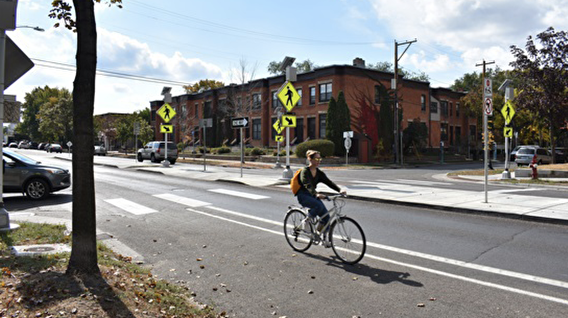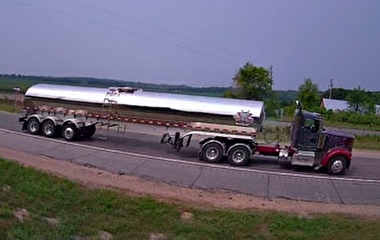
For many Minnesota communities, a road diet could help improve both safety and the user experience—but knowing when it’s a good fit can be challenging.
The term “road diet”—also known as a 4-3 conversion—describes the process of converting a four-lane road to three lanes; the converted road has two travel lanes separated by a two-way turning lane. Often, a road diet can significantly reduce crashes while making space for other infrastructure such as bikeways or transit lanes at a relatively low cost. However, little guidance exists regarding the traffic volumes at which a conversion would result in an unacceptable decrease in the level of service (LOS) for drivers.
“There hasn’t been much consensus around the traffic volumes at which a 4-3 conversion can be considered,” says Gary Davis, a professor with the U of M’s Department of Civil, Environmental and Geo- Engineering. “Some guidelines suggest below 15,000 or even 10,000 vehicles per day, while others suggest conversions can still work at volumes of greater than 20,000 per day. Our goal for this project was to develop a better understanding of road conversions and their impact on motor vehicle capacity at different traffic volumes, using 15,000 as a key threshold.”
The study was sponsored by the Minnesota Local Road Research Board.
Three roads in Minnesota were selected for a simulation study of 4-3 conversion impacts:
- 50th Street in Minneapolis between Chowen and Zenith Avenues
- Minnetonka Boulevard in St. Louis Park between Highway 100 and Inglewood Avenue
- Baker Road in Minnetonka between Highway 62 and and Valleyview Road
One of the selected locations was previously converted from four to three lanes, while the other two were candidates for conversion. The locations had traffic volumes between 10,000 and 25,000 vehicles per day and a variety of intersection configurations.

Using traffic simulations, researchers computed average motor vehicle delays at intersections and average motor vehicle speed in the corridors. The simulation results were summarized in tables showing LOS ratings. Then, eight intersection configurations were selected to represent the study’s results and serve as example intersections for acceptable and unacceptable LOS changes at various traffic volumes.
“While a detailed evaluation of design elements should precede a 4-3 road conversion, the guidance tables will allow engineers to make an initial assessment of the potential impacts to level of service,” Davis says.
Through this study, researchers learned that guidelines based solely on average daily traffic (ADT) can be misleading. Traffic volumes must be considered in tandem with motor vehicle demand on the crossroads, hourly volumes, and other factors. “Generally, we found that 4-3 conversions can be feasible for ADTs greater than 15,000 as long as demands on crossroads remain low enough,” he says.
For all three roads, simulations showed that for mainline motor vehicle traffic, the reduction in LOS was acceptable at volumes of 15,000 vehicles per day or greater. However, for minor road traffic at unsignalized intersections, the drop-off in LOS was unacceptable in some cases. In two of the locations, LOS deteriorated substantially when mainline traffic ADT exceeded 15,000. In the other location, acceptable LOS was possible up to 18,000 as long as the minor road didn’t exceed 20 percent of the mainline volume.
“The guidelines are best applied initially to identify those situations where, although main road ADTs exceed 15,000, the crossroad demands are low enough that a 4-3 conversion could remain possible,” Davis concludes. More detailed evaluation of the actual design, including specifics such as bicycle lanes, transit access, peak spreading, driver and pedestrian safety, and possible capacity improvements on crossroads, should still be considered.
“The motor vehicle traffic volume thresholds identified in this research will make the 4-3 conversion decision-making process more efficient by reducing the need for traffic analysis at low ADT thresholds,” says KC Atkins, senior transportation engineer with Hennepin County Public Works and the project’s technical liaison. “The guidance will be particularly helpful for agencies that may not have the resources to do a more in-depth traffic analysis.”
—Megan Tsai, contributing writer


